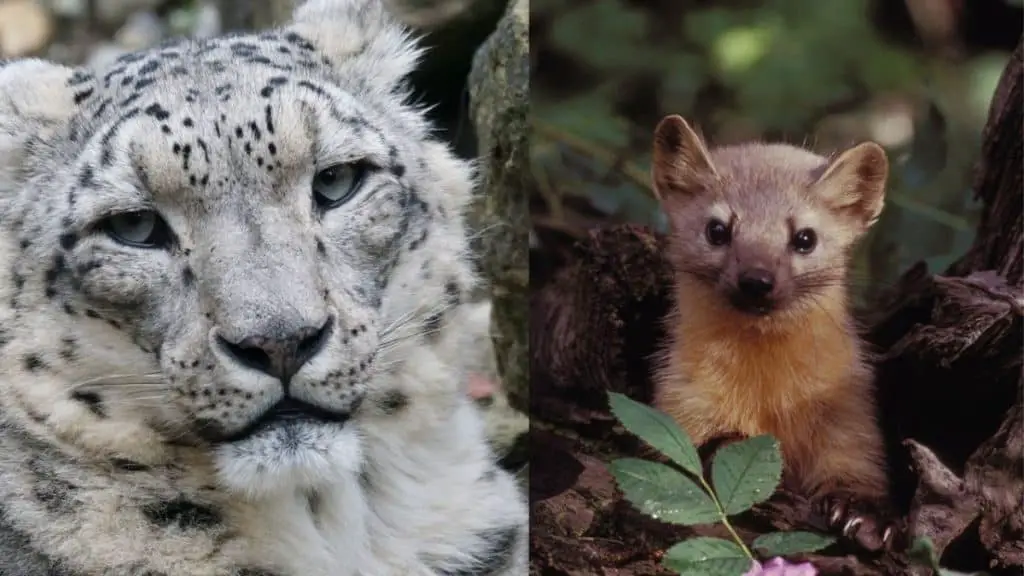The red panda is an attractive mammal found in the eastern Himalayas and southwestern China. Red pandas are wild animals and have few predators. However, the ones they have can be deadly.
Animal predators of red pandas are martens and snow leopards, which mainly feed on the cubs. Large birds of prey will also feed on the cubs but are less likely to attack adult red pandas. The primary predator of red pandas is deforestation, with around 7,000 deaths yearly in China due to urban expansion.
In this article, I look at the main predators of red pandas. It is such a shame that these beautiful animals are under attack from humans.
Do you know what red pandas eat? Find out here in this article I wrote.

What are red pandas?
It has a bear-like build and thick reddish fur. The red panda is slightly larger than a domestic cat. It has black markings on the abdomen and limbs and white markings on the side of the head.
Red pandas spend most of their time up on the trees. They have adapted to life in the trees so well that they are known for their outstanding acrobatic abilities. Red pandas have a thumb-like wrist bone that aids in gaining extra grip when climbing.
Red pandas can’t stretch their arms wide, but they can use their tails to maintain their balance. They are found in regions where the climate is mostly cold and windy. Their bushy tail helps them to insulate their body.
People mostly love them as innocent animals, which they are unless they are disturbed. Let’s discuss what the predators of red pandas are and how they defend themselves.
Do you know where red pandas live? Find out here
What are the predators of red pandas?
The red panda is arboreal and spends most of the daytime in the trees. They are found at higher altitudes, and so have few predators. The main predators of the red panda are the snow leopard and the marten. Some large birds of prey will also attack red panda cubs.

Snow leopards
Snow leopards share the same habitat with red pandas in China, India, Bhutan, and Nepal. Their predator-prey interaction is significant for a balanced food chain. Unfortunately, the snow leopard and red panda are endangered, and their population decline could disturb the whole ecosystem.
Snow leopards are good at camouflaging in the snow. As a result, red pandas are less likely to detect them. The snow leopards’ powerful leg muscles allow them to run quicker than red pandas. Snow leopards can easily outrun red pandas through most environments.
Snow leopards are active at night and in the early morning and evening hours. Snow leopards hunt in near darkness because of their exceptional eyesight and low light perception. They follow their prey almost silently before running and attacking from 20 to 50 feet. They have strong paws which help them seize the prey and crush the prey’s spine with their teeth.
Did you know giant pandas are aggressive? Find out more here
Martens
Martens can be found in forested areas of south and east Asia, where they share the habitat with red pandas. Martens are not endangered due to their wide range throughout Asia.
Martens attack young red panda cubs too young to leave their nests. This harms the red panda population as it decreases future generations of the red panda. Due to predation on young cubs, very few red pandas reach maturity.
Martens are very agile and strong animals. They are usually active during the day, but they are sometimes active at night as well. Their very sensitive hearing can track down a red panda even in the dark. They hunt alone as well as in groups to increase the chance of their success.
They are among the most ferocious predators, capable of taking on prey far larger than themselves. They have sharp claws and teeth, which help them to tear into their prey. The claws are semi-retractable, allowing them to climb rapidly and efficiently. As a result, they can chase red pandas from the tops of trees.
Do you know the main characteristics of pandas? Find out here
Humans
Humans also kill red pandas for their fur. The fur makes coats, rugs, caps, and clothing. They also poach red pandas from the wild for the illegal pet trade. They destroy the natural habitat of red pandas through habitat clearing, commercial use, and farming. The red panda population is declining majorly because of anthropogenic activities.
Approximately 10,000 red pandas die every year due. However, 7,000 of these are due to deforestation in China to build new homes.
Are red pandas dangerous? They can be. Find out more here
How do red pandas defend themselves?
When red pandas are attacked, they usually try to flee but can defend themselves when required.
Let’s have a look at how red pandas defend themselves.
⦁ When red pandas are threatened, they usually try to flee first. They are great climbers and will try to climb out of the reach of the pursuing animal. Red pandas climb trees using sharp claws on their front paws. They are not used to walking and running on the ground.
⦁ Red pandas can be very aggressive when it comes to defending themselves. Red pandas have jaws that are capable of killing most other species. After fleeing, their teeth are their second tool, which they use to bite.
⦁ When a small predator tries to enter their territory, they will grab them so tightly that the other animal’s bones will break. The red panda will then begin to bite, and because of its razor-sharp teeth, it can quickly kill the other animals.
⦁ The red panda uses a lot of body language to communicate, but it isn’t scared to make sounds. When threatened by a predator, it makes a sound similar to huffing and quacking. Red pandas can also use a whistle to warn other red pandas of a threat.
⦁ Red pandas spend most of their time on trees, making them less vulnerable to predators.
What do Red Pandas prey on?
Red pandas are carnivorous mammals. Despite being a carnivorous mammal, the Red Panda’s diet is essentially vegetarian, as bamboo shoots make up most of its diet. Bamboo shoots and leaves make up around 95 % of red pandas’ diet. Bamboo is low in proteins but high in fibre. Red pandas eat other items to supplement their diet, including berries, grasses, acorns, lizards, chicks, and bird’s eggs.
Red Pandas are endangered animals, according to IUCN. The population of this beautiful creature is declining, and there is a dire need to conserve red pandas before it’s too late. Please do anything you can to ensure their survival.
Do you know how pandas reproduce? Find out here in this article I wrote

